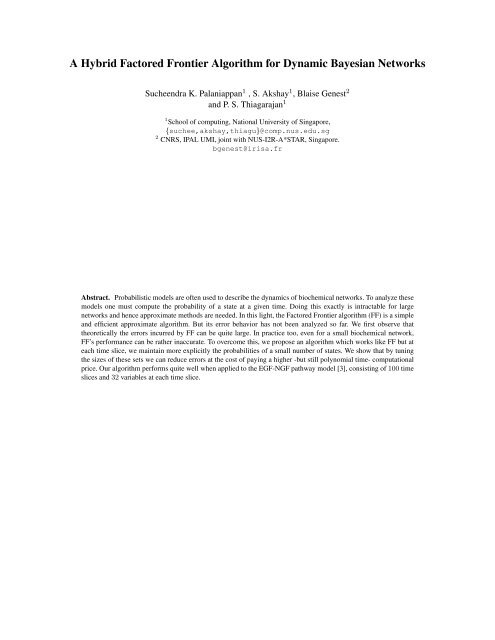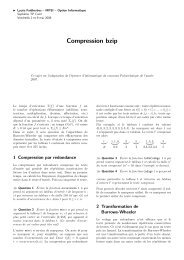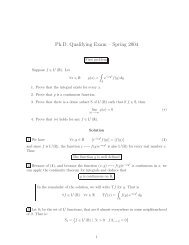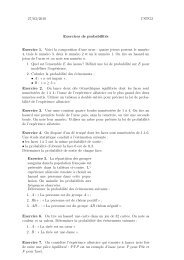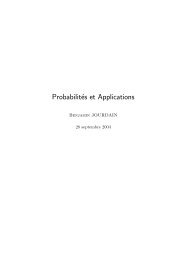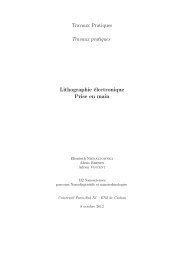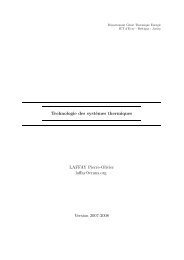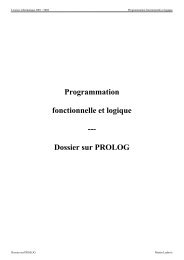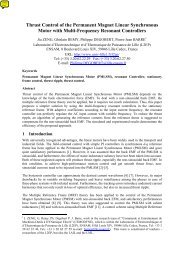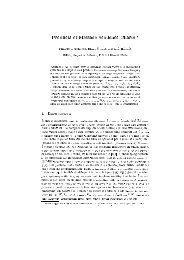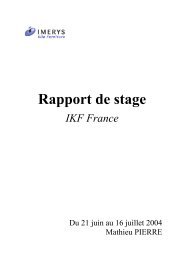A Hybrid Factored Frontier Algorithm for Dynamic Bayesian Networks
A Hybrid Factored Frontier Algorithm for Dynamic Bayesian Networks
A Hybrid Factored Frontier Algorithm for Dynamic Bayesian Networks
You also want an ePaper? Increase the reach of your titles
YUMPU automatically turns print PDFs into web optimized ePapers that Google loves.
The overall error at time t, denoted ∆ t is given by ∆ t = max u∈V n(|P (X t = u) − B t (u)|). Usinga reasoning similar to [1], this error can be bounded as: ɛ 0 ( ∑ tj=0 βj ), where 0 ≤ β ≤ 1 is a constantdetermined by the stochastic transition matrix associated with the DBN. Further, β < 1 under fairly mildrestrictions placed on the underlying Markov chain and in this case we have ∑ tj=0 βj < 1/(1 − β).A technical analysis of ɛ 0 shows that ɛ 0 converges to 1 as n, the number of variables, tends to ∞.Interestingly, the FF error on a marginal can be large in practice too. Specifically, <strong>for</strong> the simple network ofFigure 1, we get an error as high as 0.16 on one of the marginals.4 The <strong>Hybrid</strong> <strong>Factored</strong> <strong>Frontier</strong> <strong>Algorithm</strong>During the error analysis <strong>for</strong> FF, we observed that if ɛ t is large then B t (v) is large <strong>for</strong> some v and henceM t (i, v i ) is large <strong>for</strong> every i. But then there can’t be too many such v. For instance, there can be only onesuch v if we want M t (i, v i ) > 1 2 <strong>for</strong> each i. Thus if we can record Bt (v) explicitly <strong>for</strong> a small subset ofV n <strong>for</strong> which M t is high <strong>for</strong> all dimensions then one can significantly improve FF. Un<strong>for</strong>tunately this cannot be done exactly since it will involve an exhaustive search through V n . Instead we will have to do thisapproximately.Accordingly, the <strong>Hybrid</strong> FF algorithm works as follows. Starting with t = 0, we inductively computeand maintain the tuple (M t , S t , B t H , αt ), where:– M t is a marginal function.– S t ⊆ V n is a set of tuples called spikes.– BH t : V n → [0, 1] is a function such that BH t (u) = 0 if u ∉ St and ∑ u∈S t Bt H(u) < 1.– α t = ∑ u∈S t Bt H (u).We define M t H (i, v) = [M t (i, v) − ∑ {u∈S t |u i =v} Bt H (u)]/(1 − αt ) <strong>for</strong> all i and v. It is easy to observethat this is a marginal function. We next define B t as follows:B t (u) = B t H(u) + (1 − α t ) ∏ iM t H(i, u i ) (1)We need to use M t H rather than M t since cumulative weight of the contribution made by the spikes needsto be discounted from M t . This will ensure that B t is a well defined belief state. The crucial parameter <strong>for</strong>our algorithm is σ, the number of spikes we choose to maintain. The accuracy of the algorithm improvesas σ increases but so does the running time. We have found σ = n 3 to be more than ample and stillcomputationally feasible <strong>for</strong> a large network as shown in the next section.4.1 The algorithmWe initialize with M 0 = C 0 , S 0 = ∅, BH 0 = 0 and α0 = 0 and fix σ.Then, we inductively compute (M t+1 , S t+1 , B t+1H, αt+1 ) from (M t , S t , BH t , αt ) as follows.Step 1: Compute M t+1 asM t+1 (i, v) = ∑ [Cit+1 (x | uî) × BH(u)]tu∈S t+(1 − α t ) × ∑ uî[C t+1i(x | uî) × ∏ j∈îB t H(j, u j )]5
Step 2: We then compute a set S t+1 of at most σ spikes using M t+1 as follows.We want to consider as spikes u ∈ V n where M t+1 (i, u i ) is large <strong>for</strong> every i. To do so, we find aconstant η t+1 such that M t+1 (i, u i ) ≥ η t+1 <strong>for</strong> every i <strong>for</strong> a subset of V n containing σ elements and <strong>for</strong>all other u ′ , there exists i with M t+1 (i, u ′ i ) < ηt+1 . We compute η t+1 via binary search. First we fix theprecision with which we want to compute η t+1 to be ξ (we choose ξ = 10 −6 , which implies 20 iterations ofthe loop described below). The search <strong>for</strong> η t+1 proceeds as follows:– η 1 = 0 and η 2 = 1.– While η 2 − η 1 > ξ do1. η = η 1+η 22.2. Set a i to be the number of values v with M t+1 (i, v) > η.3. Set U i to be this set of values.4. If ∏ i (a i) > σ then η 1 = η; otherwise η 2 = η– endwhile– Return η t+1 = η 2 and S t+1 = ∏ i U iStep 3:Finally, we compute B t+1H(u) <strong>for</strong> each u in St+1 as follows.B t+1H(u) = ∑ (B t (v) × ∏v∈S t iCit+1 (u i | vî))4.2 Analysis of the <strong>Hybrid</strong> FFOne can establish the following properties of our algorithm. We refer the reader to the full paper [18] <strong>for</strong>the details.Proposition 1. 1. For σ = 0, the hybrid FF algorithm is the same as FF and <strong>for</strong> σ = K n , it is the exactalgorithm.2. B t is a belief state <strong>for</strong> every t.3. Suppose P t = B t . Then P t+1 (v) = M t+1 (i, v) <strong>for</strong> every i, v.4. The time complexity of hybrid FF is O(T · n · (σ 2 + K R+1 )), where T is the number of time points, nis the number of variables, σ is the number of spikes, K = |V | and R is the maximum in-degree of theDBN.We recall the time complexity of FF is O(n · K R+1 ) and hence the additional computational ef<strong>for</strong>t requiredby HFF is O(T · n · σ 2 ). However, in our applications HFF will be run as an off-line computationwhere in one sweep, the required in<strong>for</strong>mation about the belief states can be gathered. Where repeated executionsare required, such as <strong>for</strong> combinations of parameter values that best match experimental data ( [15])one can initially run FF repeatedly to narrow down the range of possibilities and then run HFF once to getan accurate estimate.The error analysis <strong>for</strong> hybrid FF proceeds along the lines <strong>for</strong> FF presented in the previous section. Theone step error, can be bounded from above by ɛ ′ 0 with ɛ′ 0 ≤ min{(1 − α), η}, where α = min t(α t ) andη = max t (η t ). In particular, if σ ≥ 1, then η ≤ 1/2 and thus ɛ ′ 0 ≤ 1/2.The cumulative error at t is then given by: ∆ ′t ≤ ɛ ′ 0 (∑ tj=0 βj ) where β is as specified in the previoussection. Thus, the worst case error is better than the one <strong>for</strong> FF, and can be much better if α is large enoughor η small enough, which we can monitor on the fly.6
0.30FF Exact Inference <strong>Hybrid</strong> FF (n^3 Spikes)0.25M t ( E, [0,1) )0.200.150.100.050.001 9 17 25 33 41 49 57 65 73 81 89 97Time pointsFig. 2. M t (E, [0, 1]) <strong>for</strong> all t5 ResultsWe have implemented our algorithm in C++. The experiments reported here were carried out on a Opteron2.2Ghz Processor. First we ran HFF on the DBN <strong>for</strong> the simple enzyme catalytic system shown in 1.We fixed the parameters of the system using known values and divided the value space of each variableinto 5 equal intervals [0, 1), [1, 2), . . . , [4, 5] and assumed the initial distributions to be uni<strong>for</strong>mly distributedover certain intervals (see [18]). The time scale of the system was set to be 10 minutes which was evenlydivided into time points ranging over [0, 1, . . . , 100] . We fixed the number of spikes to be 4 3 = 64 andran HFF and FF. This being a small example, we could compute the probability distributions over the states<strong>for</strong> each time point exactly. From this we derived the exact marginal distributions <strong>for</strong> each species. FFper<strong>for</strong>med well <strong>for</strong> the product species P . However <strong>for</strong> E, ES and S it deviated from the actual distribution<strong>for</strong> certain marginals. For instance, <strong>for</strong> E and the interval [0, 1), it deviated by as much as 0.168 <strong>for</strong> themarginal M t (E, [0, 1)) as shown in Figure 2. This figure also shows the time evolution of this marginal <strong>for</strong>HFF and the exact one. As can be seen, the HFF profile is almost the same as that of the exact one (in factthis was already the case <strong>for</strong> σ = n 2 = 16). Figure 3 shows the maximum error curves <strong>for</strong> FF and HFFrelative to the exact one; it the maximum of the errors taken over all 5 intervals at each time point. As canbe seen, the maximum error incurred by HFF is lower.Maximum absolute error <strong>for</strong> E0.180.160.140.120.10.080.060.040.020FF Error <strong>Hybrid</strong> FF Error1 9 17 25 33 41 49 57 65 73 81 89 97Time pointsFig. 3. Maximum Error of FF and HFF with respect to exact <strong>for</strong> E7
Fig. 4. EGF-NGF pathwayWe next considered the EGF-NGF pathway in PC12 cells. This cell line is a valuable model systemin neuroscience. Specifically, PC12 cells proliferate in response to EGF stimulation but differentiate intosympathetic neurons in response to NGF. This phenomenon has been intensively studied [9] with a transientactivation of Erk1/2 associated with cell proliferation, while a sustained activity has been linked todifferentiation. The network structure of this pathway shown in figure 4. The ODE model of this pathwayis available in the BioModels database [17]. It consists of 32 differential equations (one <strong>for</strong> each molecularspecies) and 48 associated rate parameters (estimated from multiple sets of experimental data). Its DBNapproximation was adapted from the one constructed in [15] and details can be found in [14]. We computedthe HFF profiles <strong>for</strong> various sizes of spikes set. Next we ran FF and compared its profiles with those of HFF.For many of the species FF did quite well. However, 6 species out of 32 exhibited a significant difference,among which were important proteins such as Activated Sos and Activated Erk.Since the DBN consisted of 3200 nodes (32 nodes per time slice; 100 time slices), with each node’svariable assuming 5 possible values, it was not possible to compute the exact probability distributions over5 32 states at each time point. However, to compare the accuracy of FF and HFF (with σ = n 3 = 32768<strong>for</strong> this DBN), one does not necessarily need the exact distribution. Denoting Mσ t (respectively, MF t F ) themarginal at time t computed by HFF with σ spikes (respectively, FF), the quantity |M t (i, v) − P (Xi t =v)| − |MF t F (i, v) − P (Xt i = v)| does not depend on the exact marginal P (Xt i = v). Rather, it depends onthe marginals (Mσ(i, t v), MF t F(i, v)) and their relative position with respect to the exact marginal.Now, as σ approaches K n (where K = |V |), α approaches 1 and thus the belief states computed by HFFapproach the exact distributions. Hence, we ran HFF with different values of σ -denoted HFF(σ)- rangingfrom HFF(3072) upto HFF(100000) and looked <strong>for</strong> a pattern. From the relative positions of the curves, andthe high value of α (always bigger than 0.6) <strong>for</strong> HFF(100000), we infer that the curve <strong>for</strong> HFF(100000) is onthe same side of FF and HFF(32768) as the exact marginal. Hence, the quantity |M t 32768 (i, v) − M t 100000 | −|M t F F (i, v)−M t 100000 | is a good approximation <strong>for</strong> |M t 32768 (i, v)−P (Xt i = v)|−|M t F F (i, v)−P (Xt i = v)|.In figure 5 we show <strong>for</strong> Activated Erk, the computed marginals of the concentration of this protein falling inthe interval [2, 3) <strong>for</strong> FF as well as HFF(3072), HFF(32768) and HFF(100000).8
αHFF ( 3072 Spikes) HFF ( 32768 Spikes) HFF (100000 Spikes)10.90.80.70.60.50.40.30.20.101 9 17 25 33 41 49 57 65 73 81 89 97Time pointsFig. 7. The evolution of α <strong>for</strong> the EGF/NGF pathway model.It took 40 hours to compute HFF(100000) to establish the standard <strong>for</strong> comparing FF and HFF(32768).For HFF(32768), it took 3.8 hours, <strong>for</strong> HFF(3072) it took 2.5 minutes, while FF took just 0.2 seconds. However,the current implementation of HFF is quite naive and sequential and there are significant opportunitiesto improve its accuracy and per<strong>for</strong>mance. Further as mentioned earlier, in our applications HFF is an off-linecomputation and hence the accuracy gained through this extra computational ef<strong>for</strong>t is quite encouraging.6 DiscussionA variety of approaches to modeling bio-pathway dynamics use Markov chains as the underlying model.A key piece of in<strong>for</strong>mation that is needed <strong>for</strong> many analysis tasks is the probability distribution of thestates at each time point. The state of the Markov chain will consist of a vector of random variables andthe dimension of this vector will correspond to the number of entities participating in the pathway. Hence,<strong>for</strong> large pathways, explicitly representing the probability distributions and exactly computing them, areboth infeasible. One must resort to approximate methods. In this light, the <strong>Factored</strong> <strong>Frontier</strong> algorithm is asimple and efficient approximate algorithm but its error behavior was not well understood till the present.It also seems to incur significant errors even <strong>for</strong> small biochemical networks. To overcome this we havepresented here an extension of FF called the <strong>Hybrid</strong> <strong>Factored</strong> <strong>Frontier</strong> algorithm. In addition to maintainingand propagating belief states in a factored <strong>for</strong>m, HFF also maintains a small number of full dimensionalstate vectors called spikes and their probabilities at each time slice. This adds a tunable parameter to FFusing which one can improve the accuracy at the price of increased but polynomial time computational cost.We have provided an error analysis <strong>for</strong> HFF as well as FF which shows that HFF can per<strong>for</strong>m better. This isalso validated by our experiments on a fairly large pathway model.Here we have used probabilistic approximations of ODE models as a source of our DBNs. It will beimportant to derive DBN models from other sources of biological relevance such as [5, 7, 13]. We plan tooptimize the implementation of our algorithm and also explore alternative methods <strong>for</strong> computing the spikesand their probabilities. Secondly, we would like to estimate the contraction factor β to bound the cumulativeerror. Further, we would like to exploit the pathway structure of the biological system [11] to further optimizeour algorithm. We are also developing other DBN models of signaling networks to which we plan to applyHFF. A related and important goal will be to develop approximated probabilistic verification techniquesbased on logics such as PCTL [6] using HFF.10


